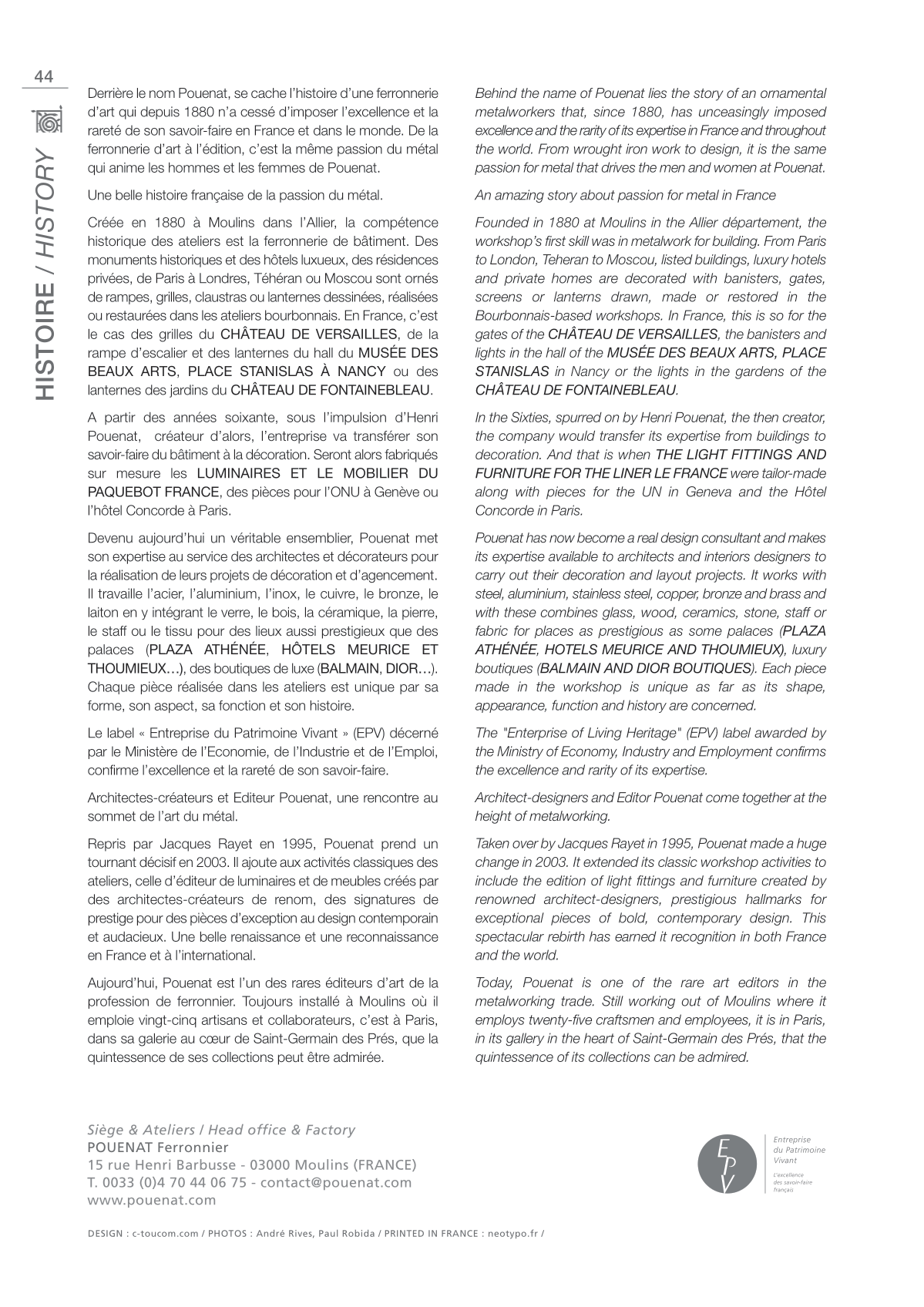HISTOIRE / HistOry
44
Derrière le nom Pouenat, se cache l’histoire d’une ferronnerie
d’art qui depuis 1880 n’a cessé d’imposer l’excellence et la
rareté de son savoir-faire en France et dans le monde. De la
ferronnerie d’art à l’édition, c’est la même passion du métal
qui anime les hommes et les femmes de Pouenat.
Une belle histoire française de la passion du métal.
Créée en 1880 à Moulins dans l’Allier, la compétence
historique des ateliers est la ferronnerie de bâtiment. Des
monuments historiques et des hôtels luxueux, des résidences
privées, de Paris à Londres, Téhéran ou Moscou sont ornés
de rampes, grilles, claustras ou lanternes dessinées, réalisées
ou restaurées dans les ateliers bourbonnais. En France, c’est
le cas des grilles du CHÂTEAU DE VERSAILLES, de la
rampe d’escalier et des lanternes du hall du MUSÉE DES
BEAUX ARTS, PLACE STANISLAS À NANCY ou des
lanternes des jardins du CHÂTEAU DE FONTAINEBLEAU.
A partir des années soixante, sous l’impulsion d’Henri
Pouenat, créateur d’alors, l’entreprise va transférer son
savoir-faire du bâtiment à la décoration. Seront alors fabriqués
sur mesure les LUMINAIRES ET LE MOBILIER DU
PAQUEBOT FRANCE, des pièces pour l’ONU à Genève ou
l’hôtel Concorde à Paris.
Devenu aujourd’hui un véritable ensemblier, Pouenat met
son expertise au service des architectes et décorateurs pour
la réalisation de leurs projets de décoration et d’agencement.
Il travaille l’acier, l’aluminium, l’inox, le cuivre, le bronze, le
laiton en y intégrant le verre, le bois, la céramique, la pierre,
le staff ou le tissu pour des lieux aussi prestigieux que des
palaces (PLAZA ATHÉNÉE, HÔTELS MEURICE ET
THOUMIEUX…), des boutiques de luxe (BALMAIN, DIOR…).
Chaque pièce réalisée dans les ateliers est unique par sa
forme, son aspect, sa fonction et son histoire.
Le label « Entreprise du Patrimoine Vivant » (EPV) décerné
par le Ministère de l’Economie, de l’Industrie et de l’Emploi,
confirme l’excellence et la rareté de son savoir-faire.
Architectes-créateurs et Editeur Pouenat, une rencontre au
sommet de l’art du métal.
Repris par Jacques Rayet en 1995, Pouenat prend un
tournant décisif en 2003. Il ajoute aux activités classiques des
ateliers, celle d’éditeur de luminaires et de meubles créés par
des architectes-créateurs de renom, des signatures de
prestige pour des pièces d’exception au design contemporain
et audacieux. Une belle renaissance et une reconnaissance
en France et à l’international.
Aujourd’hui, Pouenat est l’un des rares éditeurs d’art de la
profession de ferronnier. Toujours installé à Moulins où il
emploie vingt-cinq artisans et collaborateurs, c’est à Paris,
dans sa galerie au cœur de Saint-Germain des Prés, que la
quintessence de ses collections peut être admirée.
Behind the name of Pouenat lies the story of an ornamental
metalworkers that, since 1880, has unceasingly imposed
excellence and the rarity of its expertise in France and throughout
the world. From wrought iron work to design, it is the same
passion for metal that drives the men and women at Pouenat.
An amazing story about passion for metal in France
Founded in 1880 at Moulins in the Allier département, the
workshop’s first skill was in metalwork for building. From Paris
to London, Teheran to Moscou, listed buildings, luxury hotels
and private homes are decorated with banisters, gates,
screens or lanterns drawn, made or restored in the
Bourbonnais-based workshops. In France, this is so for the
gates of the CHÂTEAU DE VERSAILLES, the banisters and
lights in the hall of the MUSÉE DES BEAUX ARTS, PLACE
STANISLAS in Nancy or the lights in the gardens of the
CHÂTEAU DE FONTAINEBLEAU.
In the Sixties, spurred on by Henri Pouenat, the then creator,
the company would transfer its expertise from buildings to
decoration. And that is when THE LIGHT FITTINGS AND
FURNITURE FOR THE LINER LE FRANCE were tailor-made
along with pieces for the UN in Geneva and the Hôtel
Concorde in Paris.
Pouenat has now become a real design consultant and makes
its expertise available to architects and interiors designers to
carry out their decoration and layout projects. It works with
steel, aluminium, stainless steel, copper, bronze and brass and
with these combines glass, wood, ceramics, stone, staff or
fabric for places as prestigious as some palaces (PLAZA
ATHÉNÉE, HOTELS MEURICE AND THOUMIEUX), luxury
boutiques (BALMAIN AND DIOR BOUTIQUES). Each piece
made in the workshop is unique as far as its shape,
appearance, function and history are concerned.
The "Enterprise of Living Heritage" (EPV) label awarded by
the Ministry of Economy, Industry and Employment confirms
the excellence and rarity of its expertise.
Architect-designers and Editor Pouenat come together at the
height of metalworking.
Taken over by Jacques Rayet in 1995, Pouenat made a huge
change in 2003. It extended its classic workshop activities to
include the edition of light fittings and furniture created by
renowned architect-designers, prestigious hallmarks for
exceptional pieces of bold, contemporary design. This
spectacular rebirth has earned it recognition in both France
and the world.
Today, Pouenat is one of the rare art editors in the
metalworking trade. Still working out of Moulins where it
employs twenty-five craftsmen and employees, it is in Paris,
in its gallery in the heart of Saint-Germain des Prés, that the
quintessence of its collections can be admired.
Siège & Ateliers / Head office & Factory
POUENAT Ferronnier
15 rue Henri Barbusse - 03000 Moulins (FRANCE)
T. 0033 (0)4 70 44 06 75 - contact@pouenat.com
www.pouenat.com
DESIGN : c-toucom.com / PHOTOS : André Rives, Paul Robida / PRINTED IN FRANCE : neotypo.fr /
C-INT-POUENAT-EDITIONS LIMITEES_INT-40 PAGES-210X297 22/07/14 13:49 Page44


